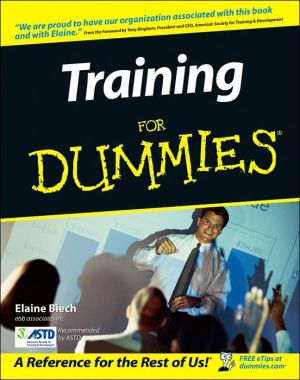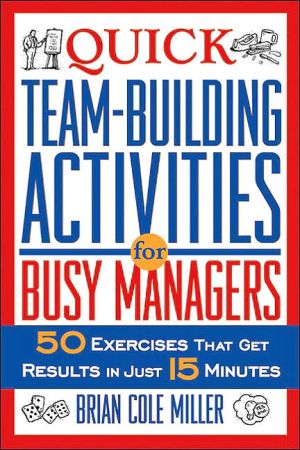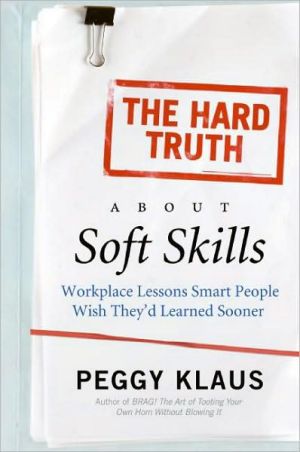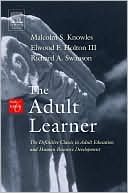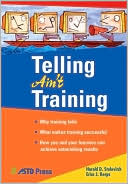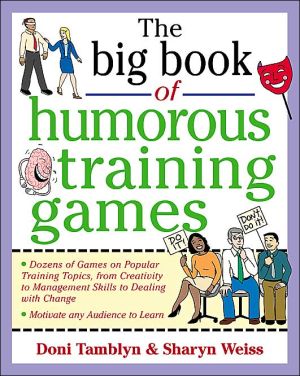Training For Dummies
Millions of Americans have to train others as part of their jobs. Whether you’re an employee training your co-workers on a new process or skill, a volunteer asked to train new volunteers, a chef training your staff, or a paramedic giving CPR training, it’s just as important to know how to teach others as it is to know what you’re talking about. It doesn’t matter how much you know about your subject if you can’t share it with others.\ Fortunately, Training For Dummies offers all the nuts and...
Search in google:
Millions of Americans have to train others as part of their jobs. Whether you’re an employee training your co-workers on a new process or skill, a volunteer asked to train new volunteers, a chef training your staff, or a paramedic giving CPR training, it’s just as important to know how to teach others as it is to know what you’re talking about. It doesn’t matter how much you know about your subject if you can’t share it with others. Fortunately, Training For Dummies offers all the nuts and bolts of training for anyone who has to educate others on any subject and in any field. It covers all the modern, interactive instructional methods and dynamic training approaches available and helps you get trainees inspired, involved, and enthused. Training For Dummies will help you: Keep it interesting so trainees learn more eagerly Master the jargon of training Use audio and visual aids effectively Prepare for the training certification process Evaluate your results and improve your tactics Elaine Biech, President and Managing Principal of Ebb Associates, Inc., and known as “the trainer’s trainer” shows you all the tips and tricks of the trade. Based on her long experience as a trainer and her work for clients such as the IRS and many Fortune 500 companies, Biech helps you discover: Tips, techniques, and tidbits for enhancing your training sessions Methods that improve trainee participation Alternatives to the traditional lecture method Tactics for gauging and managing group dynamics Strategies for addressing problems in the classroom Hintsfor understanding and adapting to different learning styles Helpful resources and other extra material you can put to immediate use No matter what you do for a living, there will probably come a time when you have to teach others what you know. Training For Dummies cuts through the complicated jargon to present the basics of teaching and learning in straightforward, plain English so you can share your specialized knowledge with those who need it.
Training For Dummies\ \ By Elaine Biech \ John Wiley & Sons\ ISBN: 0-7645-5985-0 \ \ \ Chapter One\ Why Adults Learn\ In This Chapter\ * Examining the basic principles of adult learning\ * Identifying a trainer's responsibility to ensure adults learn\ * Identifying types of learning\ * Defining training roles\ Think back to the past 60 days. What is one thing you learned? Before reading ahead, try to recall what you learned and why you learned it. Perhaps you learned to play racquetball because you always wanted to learn to play the game. Perhaps you had a flat tire on the way home, and you had to learn to change the tire because you had to do it. You didn't want to, but you had no choice.\ If you're like most adults, you learn to do most things as an adult because you want to learn it or you need to learn it.\ This chapter explores adult learning theory, how people learn, and how trainers can assist participants to learn in the classroom.\ Adult Learning Theory\ Trainers are most successful when they understand conditions under which adults learn best. Therefore, it is important to understand the difference between why adults learn and how adults are traditionally taught.\ The traditional style of teaching is based on a didactic model, a synonym for lecturing. Generally this model is teacher-led and content-centered. Another word used is pedagogy which literally means the art of teaching children.\ In the introductionto this chapter, you discovered that most adults learn things because they want to or need to. Children do, too. However, children's formal learning is usually led by someone else and is based on their learning specific tasks to prepare them to learn additional, more complicated tasks.\ For example, you learned to count to 100 in kindergarten, so that you could learn to add and subtract in first grade, so that you could learn to multiply and divide in third grade, so that you could learn algebra in eighth grade, so that you could learn trigonometry in high school, so that you could learn calculus in college.\ Most people have experienced the pedagogical model of learning. It has dominated education for centuries and assumes the following:\ \ The instructor is the expert. Because the learner has little experience it is up to the instructor to impart wisdom.\ \ \ The instructor is responsible for all aspects of the learning process, including what, how, and when the learners learn.\ \ \ Learning is content-centered. Objectives establish goals and a logical sequence of material is presented to the learners.\ \ \ Motivation is external, and learners learn because they must reach the next level of understanding, pass a test, or acquire certification.\ \ Does this sound familiar? It should. Unless you had an atypical learning situation, it is most likely how you were taught starting in kindergarten and through college. Some schools are changing however. Although the lecture method is still used, it is frequently enhanced with other learning methods. This suggests that someone has identified a better method for teaching.\ Who is Malcolm Knowles?\ Malcolm Knowles is considered the father of adult learning theory. Because pedagogy is defined as the art and science of teaching children, European adult educators coined the word andragogy to identify the growing body of knowledge about adult learning. It was Dr. Knowles' highly readable book, The Adult Learner: A Neglected Species, published in 1973, that took the topic from theoretical to practical. Table 2-1 compares the differences between andragogy and pedagogy. Trainers and adult educators began to implement practical applications based on Dr. Knowles' six assumptions.\ The following list summarizes Malcolm Knowles' six assumptions and adds a practical application from a trainer's perspective. Although there is some duplication of ideas, I have presented all six assumptions to you as Knowles identified them. Many authors distill the six to five, four, and even three.\ \ Adults have a need to know why they should learn something before investing time in a learning event. Trainers must ensure that the learners know the purpose for training as early as possible.\ \ \ Adults enter any learning situation with an image of themselves as self-directing, responsible grown-ups. Trainers must help adults identify their needs and direct their own learning experience.\ \ \ Adults come to a learning opportunity with a wealth of experience and a great deal to contribute. Trainers are successful when they identify ways to build on and make use of adults' hard-earned experience.\ \ \ Adults have a strong readiness to learn those things that help them cope with daily life effectively. Training that relates directly to situations adults face is viewed as relevant.\ \ \ Adults are willing to devote energy to learning those things that they believe help them perform a task or solve a problem. Trainers who determine needs and interests and develop content in response to these needs are most helpful to adult learners.\ \ \ Adults are more responsive to internal motivators such as increased self-esteem than external motivators such as higher salaries. Trainers can ensure that this internal motivation is not blocked by barriers such as a poor self-concept or time constraints by creating a safe learning climate.\ \ Applying adult learning theory to training\ I don't know whether Malcolm Knowles had this in mind when he presented his adult learning theory to the world, but it seems that he is talking about responsibility. Furthermore, whether you're the trainer or the learner you have responsibility to ensure that the training is successful, that learning occurs, and that change takes place.\ If you're the trainer\ \ Create a learning environment that is safe.\ \ \ Be organized, have well-defined objectives, and establish a clear direction for your session based on the participants' needs. Be so well organized that it is easy to be flexible when the participants' needs are different from what you anticipated.\ \ \ Ensure that your content is meaningful and transferable to the learners' world.\ \ \ Treat your learners with respect, understanding, and genuine concern.\ \ \ Invite learners to share their knowledge and experiences.\ \ If you're the learner\ \ Be an active learner, participating in the interactive exercises.\ \ \ Be critical of poorly defined sessions, an unprepared trainer, or processes that prevent your learning; provide constructive feedback to the trainer.\ \ \ Ensure your personal success by encouraging feedback from the trainer.\ \ CERTIFICATION INFO\ Delivering constructive feedback is a key action expected of all professional trainers. Learners have a right to receive feedback from their trainers.\ \ Recognize that you're responsible for your own learning, so ensure that all your questions are answered.\ \ \ Contribute to your own success by clearly identifying a learning plan for yourself; then do your part to achieve your objectives.\ \ Trainers beware! Note that I encourage learners to be critical of you if you're not prepared or the session doesn't meet their needs. Why? Professional trainers profess to build on the foundation of adult learning theory. If something is not working, step back, determine why, and fix it. If you're not doing that, you're not practicing good adult learning principles. You may need another trainer to guide you.\ How Do People Learn?\ The adult learning theory presented in the previous section provides a foundation of principles of adult learning. However, there are additional considerations to enhance results when training adults. In the following sections, I examine them.\ Three types of learning: KSAs\ Trainers address three types of learning: knowledge (K), skills (S), and influencing attitude (A). Trainers frequently shorten this to the KSA acronym. (If you want the research to support this, it is called Bloom's Taxonomy.)\ Knowledge (Bloom called this cognitive) involves the development of intellectual skills. Examples of knowledge include understanding the principles of accounting, knowing the stages of childhood, understanding how interest rates affect the economy, or knowing how to get a book published.\ Skills (Bloom called this psychomotor) refers to physical movement, coordination, and the use of the motor-skills area. Examples of skills you may learn include the ability to use a digital camera, operate a backhoe, supervise staff, listen effectively, or kick a soccer ball.\ Attitude (Bloom called this affective) refers to how you deal with things emotionally, such as feelings, motivation, and enthusiasm. Although attitude is not "taught," training may affect it. Trainers cannot change attitudes, but they frequently have the opportunity to influence attitudes.\ REMEMBER\ Trainers sometimes discuss whether it is the learner's skill or will that prevents topnotch performance following a training session. This refers to the fact that an employee may have learned the skill but is unwilling to use it. Therefore, the real reason an employee may not be using what was learned may not be skill-based at all. It may be that the employee won't use the skill that was learned.\ Knowing that there are three types of learning means that you need to use different methods to address each. I discuss this in more depth in Chapter 5 when I address design.\ Other considerations for learning\ How do you gain information? Hear? See? Do you also touch? Smell and taste, too? You bet you do! We all gain information through our five senses. The highest percent of information usually comes through seeing and hearing.\ NAMES TO KNOW\ Many people have theories about how humans learn best. David Kolb, for example, presents four learning styles: the converger, the diverger, the assimilator, and the accommodator. Another theory was developed by W. E. (Ned) Herrmann. His research shows brain specialization in four quadrants and that each quadrant has its own preferred way of learning. Ned's daughter Ann Herrmann-Nehdi continues to enhance her father's work.\ Still a third theory, Neurolinguistic Programming (NLP), proposes that everyone takes information in through three modalities: visual, auditory, and kinesthetic. Most people use a combination of all three modalities. Preferred learning styles determine how your participants assimilate, sort, retain, retrieve, and reproduce new information.\ Visual learners, for example, prefer pictures, diagrams, and other visuals. They probably need to "see it" to "know it." They may have artistic ability and a strong sense of color. They may have difficulty following directions or learning from lectures. They may overreact to noise or misinterpret words.\ How can you create a learning environment that is conducive for the visual learner? Consider these.\ \ Provide written directions when possible.\ \ \ Enhance presentations with visuals, graphics, illustrations, diagrams, props, or flowcharts.\ \ \ Create a colorful classroom with neon sticky-back notes, posters, colorful and coordinated markers, crayons, and participant materials.\ \ \ Provide paper (colorful) and markers for doodling and taking notes.\ \ \ Help participants visualize a process using films, demonstrations, or role plays to "show" how.\ \ \ Color code participant materials or use icons to help them find their way.\ \ Auditory learners, on the other hand, prefer to get information by listening. They need to "hear it" to "know it." They may have difficulty following written directions or any activity that includes reading.\ How can you create a learning environment that is conducive for the auditory learner? Consider these.\ \ Provide spoken directions, when possible.\ \ \ Use discussions, tapes, debates, panels, interviews, and other verbal methods for transferring knowledge.\ \ \ Plan for buzz groups, small group discussion, teach-backs, and presentations that allow participants to talk through the information.\ \ \ Avoid subtle body language or facial expression to make a point.\ \ \ Create learning activities in which learners repeat the information.\ \ Finally, kinesthetic learners prefer hands-on learning. They need to "do it" to "know it." They assemble things without reading directions and usually have good spatial perception. They learn best when they are actively involved.\ How can you create a learning environment that is conducive for the kinesthetic learner? Consider these.\ \ Provide physically active learning opportunities.\ \ \ Engage them in experiential, hands-on learning activities.\ \ \ Provide things for them to touch and "play with" such as Play Doh, tactile toys, koosh balls, and crayons.\ \ \ Take frequent breaks or allow informal movement during the session that doesn't disturb other participants.\ \ \ Build in activities such as making models, role playing, scavenger hunts, relay races, and other active review and practice methods.\ \ \ Use computers to reinforce learning.\ \ \ Find ways other than testing to express knowledge and skills, such as demonstrations.\ \ You usually encounter all of these learning styles in a training session at one time.\ So what does a trainer do? It is not usually possible to address all the learning preferences all the time in a group. Do what all good trainers do.\ \ Accept that people learn in different ways.\ \ \ Use different methods that facilitate learning for different preferences.\ \ \ And finally, when designing or delivering training, strive to create a variety of approaches that utilize techniques and activities from all learning preferences.\ \ Helping Adults Learn in the Classroom\ You may have a difficult time finding practical advice to ensure that the training room - your workplace - maximizes adult learning. However, in 25 years of experience in classrooms, I've discovered practical tips for applying Malcolm Knowles' principles to ensure that participants learn. I've grouped them in four categories for you.\ \ Create a safe haven for learning.\ \ \ Create a comfortable environment.\ \ \ Encourage participation.\ \ \ Facilitate more than you lecture.\ \ In the following sections, I examine each of these and help you decide how you can address them.\ Create a safe haven for learning\ It would be great if everything you did as a trainer went just the way it is supposed to, but it won't. Trust me. Some learners may arrive thinking that training is punishment. Others may arrive with memories of past learning experiences in mind, such as failing tests. Yet others may arrive bringing their daily burdens with them. You can create a safe haven for everyone by using some of these ideas.\ \ Be prepared early enough so that you can greet participants at the door, welcome them, learn their names, and allow time for them to tell you something that's important to them.\ \ \ Share the objectives of the training early, prior to the session, if possible.\ \ \ Let participants know how they stand to benefit from the information.\ \ \ Demonstrate your respect for each individual.\ \ \ Ensure confidentiality - "what's said in the room, stays in the room."\ \ \ Add something whimsical to pique curiosity and add a smile. This may be crayons, clay, koosh balls, or manipulative toys.\ \ \ Use names and sincere reinforcement to build rapport.\ \ TIP\ I like to use table tents (card stock folded in half length-wise) on which participants write their names. Some trainers prefer to use name badges. Whatever your choice, be sure that you can read them. For example, ask participants to write their first names large enough so that everyone can read them from across the room. If you use preprinted table tents, ensure that the type size is bold and can be read from 40 feet. Also, if water glasses are placed on the tables, bunch them up in one spot so that participants take them as they need them. Otherwise, there will be one sitting in front of each table tent, and you will be unable to read the names.\ (Continues...)\ \ \ \ \ Excerpted from Training For Dummies by Elaine Biech Excerpted by permission.\ All rights reserved. No part of this excerpt may be reproduced or reprinted without permission in writing from the publisher.\ Excerpts are provided by Dial-A-Book Inc. solely for the personal use of visitors to this web site. \ \
Introduction. Part I: So You’re Going to Be a Trainer! Chapter 1: What’s a Trainer? Chapter 2: Why Adults Learn. Chapter 3: The Training Cycle. Part II: Designing the Best Darn Training In the World. Chapter 4: Assessing Needs and Developing Learning Objectives. Chapter 5: Developing the Training Design. Chapter 6: Using Off-the-Shelf Training. Chapter 7: Being Prepared to Succeed. Part III: Showtime: Delivering a Dynamic Training Session. Chapter 8: Implementing Training Designs: Your Job as Facilitator. Chapter 9: It’s Showtime: Delivering Success. Chapter 10: Mastering Media and Other Visuals. Chapter 11: Training with Style. Chapter 12: Addressing Problems: What’s a Trainer to Do? Part IV: It’s Not Over Yet: The Follow-Up. Chapter 13: Evaluation: It’s Not Over Yet! Chapter 14: Transfer of Learning. Part V: The Professional Trainer. Chapter 15: The Consummate Professional. Chapter 16: Training Certification. Chapter 17: Training Trends. Part VI: The Part of Tens. Chapter 18: Ten Tips to Start Off on the Right Foot. Chapter 19: Ten Ways to Increase Participation. Chapter 20: Ten Ways to Save Time in the Training Room. Chapter 21: Ten Quick Ways to Form Small Groups. Chapter 22: Ten Tips for Adding Humor to Training. Chapter 23: Ten Icebreakers That Work. Index.
